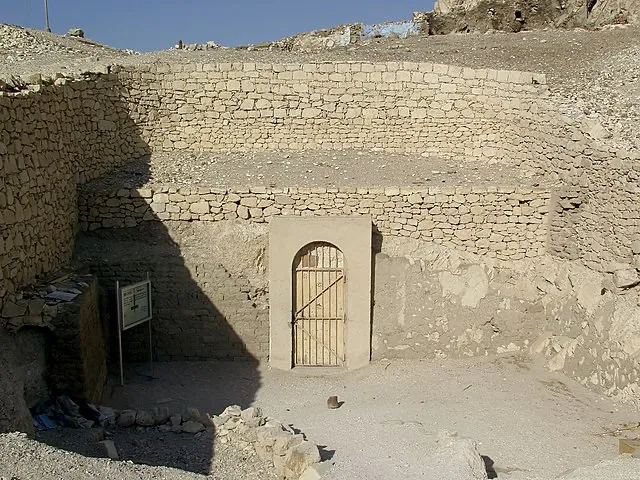The Tomb of Menna is a significant archaeological site located in the Theban Necropolis, on the west bank of the Nile, opposite Luxor, Egypt. It is the burial place of Menna, a high-ranking official during the reign of Pharaoh Thutmose IV of the 18th Dynasty. The tomb is renowned for its well-preserved wall paintings that depict various aspects of Egyptian life and the afterlife. These artworks provide valuable insights into the customs, religious beliefs, and daily activities of ancient Egyptians. The Tomb of Menna is a popular destination for scholars and tourists alike, offering a glimpse into the rich history and culture of ancient Egypt.
Get your dose of History via Email
Historical Background of the Tomb of Menna
The Tomb of Menna was discovered in the 19th century, though the exact date and discoverer remain uncertain. It was built during the 18th Dynasty, under the rule of Pharaoh Thutmose IV. Menna, the tomb’s owner, was a “Scribe of the Fields of the Lord of the Two Lands,” responsible for overseeing agricultural estates and ensuring the pharaoh’s landholdings were productive. His position was one of significant importance, reflecting the tomb’s elaborate design and decoration.
Over the centuries, the tomb suffered from natural decay and human interference. However, it remained relatively intact compared to other tombs in the area. The site has not been the scene of any historically important events, but it has provided historians and archaeologists with a wealth of information about the period. The tomb’s inscriptions and art have been crucial in understanding the socio-economic aspects of the New Kingdom.
Restoration efforts have been undertaken to preserve the Tomb of Menna. These efforts aim to stabilize the structure, prevent further deterioration of the paintings, and maintain the tomb’s integrity for future generations. The restoration has also allowed for a more detailed study of the tomb’s art and inscriptions, leading to new insights into ancient Egyptian culture.
While the tomb was not inhabited after Menna’s time, it has been visited by countless individuals over the millennia. These visitors, ranging from ancient tomb robbers to modern tourists, have left their marks on the site. Fortunately, the most valuable aspects of the tomb, particularly the wall paintings, have survived these intrusions.
The Tomb of Menna is not only a burial site but also a cultural treasure. It stands as a testament to the craftsmanship and artistic skill of ancient Egyptian artisans. The tomb’s preservation allows us to appreciate the continuity of human expression and reverence for the afterlife that characterized ancient Egyptian civilization.
About the Tomb of Menna
The Tomb of Menna, designated as TT69, is an example of the rock-cut tombs typical of the New Kingdom period. The tomb’s layout includes a transverse hall leading to a smaller, longitudinal chamber where the burial would have taken place. The walls of the tomb are adorned with vibrant paintings that have retained much of their original color and detail.
The artwork within the tomb depicts various scenes from Menna’s life and the afterlife. These include agricultural activities, hunting in the marshes, and banqueting scenes. The paintings also illustrate traditional funerary rituals and the journey of the deceased through the underworld, guided by the gods.
The construction of the tomb involved cutting into the limestone cliffs of the Theban hills. The builders used chisels and hammers to shape the chambers and corridors. Once the structure was carved out, artisans applied a layer of plaster to the walls, which served as the canvas for the intricate paintings.
Architectural highlights of the tomb include the use of columns carved into the rock to support the roof of the transverse hall. The columns are decorated with lotus and papyrus motifs, symbolizing Upper and Lower Egypt. The ceiling is adorned with geometric patterns and stars, representing the night sky.
The materials used in the construction and decoration of the tomb were locally sourced. The limestone for the structure came from the nearby hills, while pigments for the paintings were derived from natural minerals. These materials have contributed to the longevity of the tomb’s artwork, allowing it to survive for millennia.
Theories and Interpretations
Several theories have been proposed regarding the Tomb of Menna, particularly about the symbolism in its artwork. Scholars believe the scenes reflect the ancient Egyptians’ beliefs about the afterlife and the importance of agriculture and fertility in their society.
The tomb’s depictions of daily life activities are not merely artistic expressions: they also serve a religious function. It is thought that these images provided the deceased with the necessary resources in the afterlife. The scenes of banqueting and abundance ensured that Menna would never lack food or enjoyment in the world beyond.
Interpretations of the funerary texts and images have been matched to historical records, confirming the accuracy of ancient Egyptian religious practices. These interpretations have also shed light on the roles and responsibilities of officials like Menna within the pharaonic administration.
Dating of the tomb has been carried out through stylistic analysis of the art and hieroglyphic inscriptions. These methods have confirmed the tomb’s construction during the reign of Thutmose IV. However, no radiometric dating techniques, such as carbon dating, have been applied to the site, as they are not suitable for the materials and the context.
The mysteries of the Tomb of Menna, particularly the condition and vibrancy of the paintings, continue to intrigue scholars. While much is known about the tomb, ongoing research and advances in technology may reveal further secrets in the future.
At a glance
- Country: Egypt
- Civilization: Ancient Egyptian (18th Dynasty)
- Age: Approximately 1400 BC

